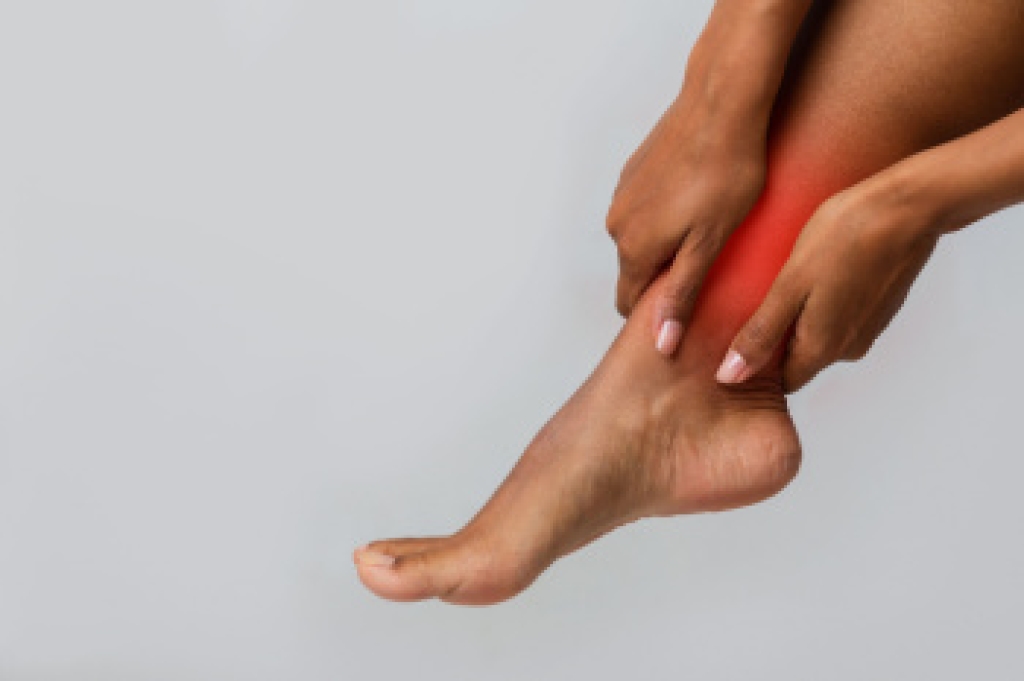Blog
Using Resistance Band Exercises for the Feet

Resistance bands are elastic tools that can be used to strengthen the muscles of the feet and ankles. These bands come in varying levels of resistance, allowing for gradual strengthening of the smaller stabilizing muscles that support balance, arch structure, and gait control. Exercises using resistance bands, such as foot flexes, toe curls, and ankle rotations, help improve flexibility, coordination, and joint stability. They are also useful for those recovering from foot injuries or seeking to prevent strain from repetitive movements. By maintaining proper form during each exercise, the muscles of the feet can become stronger, which supports better movement and reduces the risk of overuse injuries. A podiatrist can assess foot mechanics, identify muscle weakness, and recommend the most effective exercises for specific needs. For guidance on resistance band exercises for the feet, it is suggested that you make an appointment with a podiatrist for a diagnosis and treatment.
Exercising your feet regularly with the proper foot wear is a great way to prevent injuries and build strength. If you have any concerns about your feet, contact Monique Mitchell, DPM from Family Foot Centre. Our doctor can provide the care you need to keep you pain-free and on your feet.
Exercise for Your Feet
Exercise for your feet can help you gain strength, mobility and flexibility in your feet. They say that strengthening your feet can be just as rewarding as strengthening another part of the body. Your feet are very important, and we often forget about them in our daily tasks. But it is because of our feet that are we able to get going and do what we need to. For those of us fortunate enough to not have any foot problems, it is an important gesture to take care of them to ensure good health in the long run.
Some foot health exercises can include ankle pumps, tip-toeing, toe rises, lifting off the floor doing reps and sets, and flexing the toes. It is best to speak with Our doctor to determine an appropriate regimen for your needs. Everyone’s needs and bodies are different, and the activities required to maintain strength in the feet vary from individual to individual.
Once you get into a routine of doing regular exercise, you may notice a difference in your feet and how strong they may become.
If you have any questions, please feel free to contact our office located in Garden Hills, Nassau, Bahamas . We offer the newest diagnostic and treatment technologies for all your foot care needs.
Understanding Arch Pain and How to Find Relief

Arch pain is a common foot complaint that affects people of all ages. It often feels like a burning or aching sensation in the bottom of the foot, especially in the arch area. Symptoms may worsen after long periods of standing, walking, or physical activity. Causes can include plantar fasciitis, flat feet, high arches, overuse injuries, or wearing unsupportive footwear. The arch may appear swollen, red, or tender to the touch. A podiatrist can provide an accurate diagnosis through a physical exam, gait analysis, and possibly imaging tests. Depending on the cause, treatment includes custom orthotics, stretching exercises, footwear recommendations, or anti-inflammatory medications. In more severe cases, injections or surgery may be considered. Arch pain can interfere with daily activities and overall comfort, so it is suggested that you make an appointment with a podiatrist to address the issue and restore healthy foot function.
Foot Pain
Foot pain can be extremely painful and debilitating. If you have a foot pain, consult with Monique Mitchell, DPM from Family Foot Centre. Our doctor will assess your condition and provide you with quality foot and ankle treatment.
Causes
Foot pain is a very broad condition that could be caused by one or more ailments. The most common include:
- Bunions
- Hammertoes
- Plantar Fasciitis
- Bone Spurs
- Corns
- Tarsal Tunnel Syndrome
- Ingrown Toenails
- Arthritis (such as Gout, Rheumatoid, and Osteoarthritis)
- Flat Feet
- Injury (from stress fractures, broken toe, foot, ankle, Achilles tendon ruptures, and sprains)
- And more
Diagnosis
To figure out the cause of foot pain, podiatrists utilize several different methods. This can range from simple visual inspections and sensation tests to X-rays and MRI scans. Prior medical history, family medical history, and any recent physical traumatic events will all be taken into consideration for a proper diagnosis.
Treatment
Treatment depends upon the cause of the foot pain. Whether it is resting, staying off the foot, or having surgery; podiatrists have a number of treatment options available for foot pain.
If you have any questions, please feel free to contact our office located in Garden Hills, Nassau, Bahamas . We offer the newest diagnostic and treatment technologies for all your foot care needs.
Preventing Ankle Sprains in Football

Ankle sprains are common in football due to sudden changes in direction, tackles, uneven surfaces, and high-impact movements. Symptoms include pain, swelling, bruising, and difficulty walking or bearing weight. Sprains are classified by severity. First degree involves mild ligament stretching with minimal swelling and usually recovers within one to two weeks. Second degree includes partial ligament tears, moderate swelling and bruising, and may take three to six weeks to heal. Third degree is a complete tear, causing severe pain, instability, and requiring six to twelve weeks or longer for recovery. A podiatrist can assess the injury, provide bracing or supportive devices, recommend rehabilitation exercises, and guide a safe return to play. If you have sustained an ankle injury, it is suggested that you consult a podiatrist who can provide an accurate diagnosis and offer effective treatment solutions.
Ankle and foot injuries are common among athletes and in many sports. They can be caused by several problems and may be potentially serious. If you are feeling pain or think you were injured in a sporting event or when exercising, consult with Monique Mitchell, DPM from Family Foot Centre. Our doctor will assess your condition and provide you with quality foot and ankle treatment.
Common Injuries
The most common injuries that occur in sporting activities include:
- Achilles Tendonitis
- Achilles Tendon Rupture
- Ankle Sprains
- Broken Foot
- Plantar Fasciitis
- Stress Fractures
- Turf Toe
Symptoms
Symptoms vary depending upon the injury and in some cases, there may be no symptoms at all. However, in most cases, some form of symptom is experienced. Pain, aching, burning, bruising, tenderness, tightness or stiffness, sensation loss, difficulty moving, and swelling are the most common symptoms.
Treatment
Just as symptoms vary depending upon the injury, so do treatment options. A common treatment method is known as the RICE method. This method involves rest, applying ice, compression and elevating the afflicted foot or ankle. If the injury appears to be more serious, surgery might be required, such as arthroscopic or reconstructive surgery. Lastly, rehabilitation or therapy might be needed to gain full functionality in the afflicted area. Any discomfort experienced by an athlete must be evaluated by a licensed, reputable medical professional.
If you have any questions please contact our office located in Garden Hills, Nassau, Bahamas . We offer the newest diagnostic and treatment technologies for all your foot and ankle needs.
When Ankle Pain Appears Without an Obvious Injury

It can be surprising to feel ankle pain when you have not twisted, fallen, or had any clear accident. However, sudden discomfort can develop from issues that build quietly over time. Conditions such as tendon inflammation, gout, arthritis, or even nerve irritation can cause swelling and pain without a recent injury. Sometimes, repetitive motion or wearing unsupportive shoes places extra stress on the ankle joint and surrounding ligaments, leading to stiffness or tenderness. Ignoring these early signs can allow the problem to worsen, making walking or standing uncomfortable. A podiatrist can perform a detailed evaluation to identify the true cause of the pain and recommend treatment, such as rest, supportive footwear, targeted exercises, or medication to reduce inflammation. If ankle pain appears suddenly or persists without explanation, it is suggested that you schedule a podiatric visit for a diagnosis and appropriate care.
Ankle pain can be caused by a number of problems and may be potentially serious. If you have ankle pain, consult with Monique Mitchell, DPM from Family Foot Centre. Our doctor will assess your condition and provide you with quality foot and ankle treatment.
Ankle pain is any condition that causes pain in the ankle. Due to the fact that the ankle consists of tendons, muscles, bones, and ligaments, ankle pain can come from a number of different conditions.
Causes
The most common causes of ankle pain include:
- Types of arthritis (rheumatoid, osteoarthritis, and gout)
- Ankle sprains
- Broken ankles
- Achilles tendonitis
- Achilles tendon rupture
- Stress fractures
- Bursitis
- Tarsal tunnel syndrome
- Plantar fasciitis
Symptoms
Symptoms of ankle injury vary based upon the condition. Pain may include general pain and discomfort, swelling, aching, redness, bruising, burning or stabbing sensations, and/or loss of sensation.
Diagnosis
Due to the wide variety of potential causes of ankle pain, podiatrists will utilize a number of different methods to properly diagnose ankle pain. This can include asking for personal and family medical histories and of any recent injuries. Further diagnosis may include sensation tests, a physical examination, and potentially x-rays or other imaging tests.
Treatment
Just as the range of causes varies widely, so do treatments. Some more common treatments are rest, ice packs, keeping pressure off the foot, orthotics and braces, medication for inflammation and pain, and surgery.
If you have any questions please feel free to contact our office located in Garden Hills, Nassau, Bahamas . We offer the newest diagnostic tools and technology to treat your foot and ankle needs.

